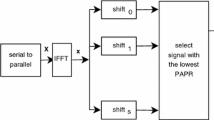Abstract
Orthogonal frequency division multiplexing (OFDM) is perhaps the most spectrally efficient, robust transmission technique discovered so far for communication systems, and it also mitigates the problem of multipath environment. High peak-to-average power ratio (PAPR) has always been a major drawback of the OFDM systems. In this article, a new precoding technique has been proposed based on Vandermonde-like matrix (VLM) and selective mapping (SLM) to reduce PAPR in OFDM systems. VLM precoding reduces the autocorrelation of the input sequences while SLM takes an advantage of the fact that the PAPR is very sensitive to phase shifts of the signal. The main advantage of this proposed scheme is to achieve a significant reduction in PAPR without increasing the system complexity. Computer simulations show that, the proposed method outperforms the existing precoding techniques without degrading the error performance of the system.









Similar content being viewed by others
References
Wu, Y. W., & Zou, Y. (1995). Orthogonal frequency division multiplexing: A multi-carrier modulation scheme. IEEE Transactions on Consumer Electronics, 41(3), 392–399.
Zou, W. Y., & Wu, Y. (1995). COFDM: An overview. IEEE Transactions on Broadcasting, 41(1), 1–8.
Jiang, T., Xiang, W., Chen, H. H., & Ni, Q. (2007). Multicast broadcasting services support in OFDMA-based WiMAX systems. IEEE Communications Magazine, 45(8), 78–86.
Han, S. H., & Lee, J. H. (2005). An overview of peak-to-average power ratio reduction techniques for multicarrier transmission. IEEE Personal Communications, 12(2), 56–65.
Jiang, T., & Wu, Y. (2008). An overview: Peak-to-average power ratio reduction techniques for OFDM signals. IEEE Transactions on Broadcasting, 54(2), 257–268.
Bauml, R. W., Fisher, R. F. H., & Huber, J. B. (1996). Reducing the peak-to-average power ratio of multicarrier modulation by selected mapping. IEE Electronics Letters, 32(22), 2056–2057.
Heo, S. J., Noh, H. S., No, J. S., & Shin, D. J. (2007). A modified SLM scheme with low complexity for PAPR reduction of OFDM systems. IEEE Transactions on Broadcasting, 53(4), 804–808.
Park, M., Heeyong, J., Cho, J., Cho, N., Hong, D., & Kang, C. (2000). PAPR Reduction in OFDM Transmission Using Hadamard Transform. In IEEE international conference on communications (Vol. 1, pp. 430–433).
Baig, I., & Jeoti, V. (2011). A new DHT precoding based Interleaved-OFDMA uplink system with improved PAPR for 4G cellular networks. Journal of Engineering Science and Technology (JESTEC), 6(6), 685–694.
Baig, I., & Jeoti, V. (2013). A ZCMT precoding based multicarrier OFDM system to minimize the high PAPR. Wireless Personal Communications, 68(3), 1135–1145. doi:10.1007/s11277-012-0501-1.
Baig, I., & Jeoti, V. (2011). A novel ZCMT precoded interleaved-OFDMA uplink system for 4G cellular systems: PAPR performance. IETE Journal of Research, 57(6), 557–562.
Sun, E., Yi, K., Tian, B., & Wang, X. (2006). A method for PAPR reduction in MSE-OFDM systems. In Advanced information networking and applications, 2006. AINA 2006. 20th international conference on (Vol. 2, p. 4).
Baig, I., & Jeoti, V., (2010) DCT precoded SLM technique for PAPR reduction in OFDM systems. In 2010 international conference on intelligent and advanced systems (ICIAS) (pp. 1–6).
Yuan-Pei, L., & See-May, P. (2003). BER minimized OFDM systems with channel independent precoders. IEEE Transactions on Signal Processing, 51(9), 2369–2380.
Hamming, R. W. (1973). Numerical methods for scientists and engineers (2nd ed.). New York: McGraw-Hill.
Higham, N. J., & Higham, D. J. (1989). Large growth factors in Gaussian elimination with pivoting. SIAM Journal on Matrix Analysis and Applications, 10, 155–164.
Zhong, X., & Zhaoyong, Y. (1998). A fast algorithm for inversion of confluent Vandermonde-like matrices involving polynomials that satisfy a three-term recurrence relation. SIAM Journal of Matrix Analysis and Applications, 19(3), 797–806.
Tellambura, C. (2000). Upper bound on peak factor of N-multiple carriers. Electronics Letter, 36(14), 1226–1228.
IEEE 802.11a, Part 11 (1999). Wireless LAN, medium access control (MAC) and physical layer (PHY) specifications: High-speed physical layer in the 5GHz band, supplement to IEEE 802.11 standard.
European Standard (EN) 300 744 V1.5.1. (2004). Digital video broadcasting (DVB); framing structure, channel coding and modulation for terrestrial television.
Vassilevska Williams, V. (2012). Multiplying matrices faster than Coppersmith-Winograd. In Proceedings of the 44th ACM symposium on theory of computing (pp. 887–898). New York: Association for Computing Machinery.




